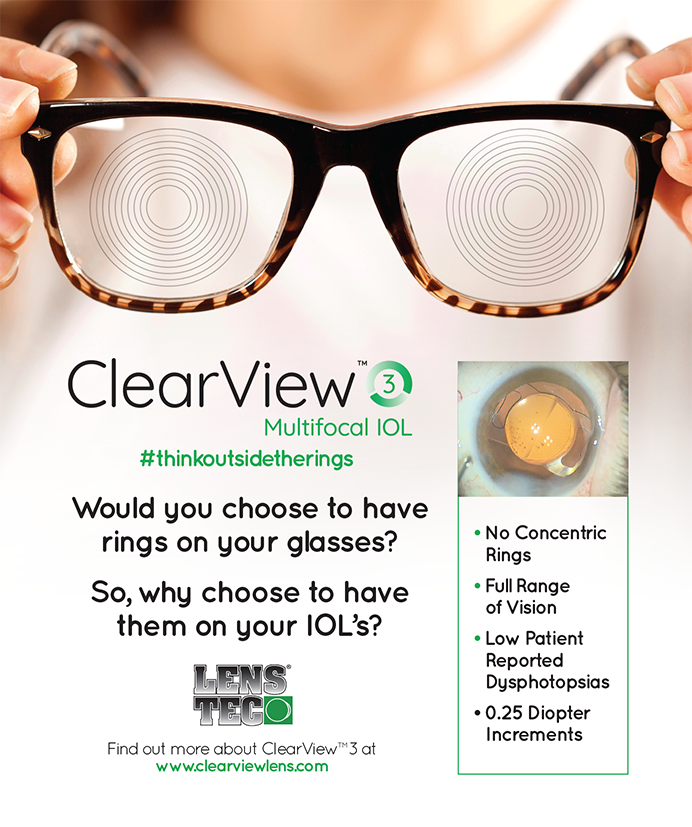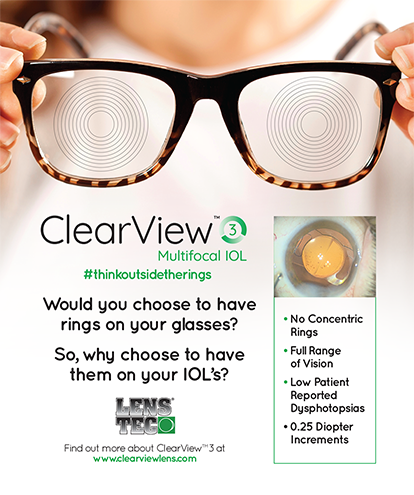My experience with several patients whose cataract surgeries were complicated by subchoroidal hemorrhages has convinced me of the importance of preventing spikes in blood pressure during this procedure. I first suspected that seemingly innocuous elevations in systolic blood pressure could complicate cataract surgery in these eyes during the case described herein.
CASE PRESENTATION
A 59-year-old female with a lifelong history of severe hyperopia was referred to me for cataract surgery. Her visual acuity had recently declined from 20/60 OU to 13.75 -2.25 X103 = 20/100 OD and 14.50 -1.75 X62 = 20/70 OS. The patient had undergone laser peripheral iridotomy in both eyes 7 years earlier because of anatomically narrow angles. She did not have a history of glaucoma. On slit-lamp examination, both pupils measured 1 mm and were fixed to 360° of the iris with posterior synechiae. The anterior chambers were extremely shallow, and I observed bilateral nuclear cataracts. Gonioscopy revealed that the angles of both eyes were open minimally (slits only) over 360°. I could not visualize the ocular fundus at that time. The keratometry readings were 51.75 X52.50/20° OD and 51.25 X52.50/140° OS. Corneal topography revealed symmetric astigmatism in both eyes with no inferior steepening. The patient's axial length measured 15.7 mm OD and 15.8 mm OS.
SURGICAL COURSE
The patient was scheduled for combined cataract surgery and posterior synechiolysis on her right eye under topical anesthesia. After I completed the posterior synechiolysis through a small limbal incision, I performed an inferotemporal pars plana vitrectomy (without delivery of infusion) to deepen the anterior chamber prior to phacoemulsification.
During the vitrectomy, the patient's globe became hard to palpation, indicating a significant increase in IOP. I suspected that a subchoroidal hemorrhage had developed and decided to terminate the vitrectomy. At that time, the patient's blood pressure measured 190/100 mm Hg, and indirect ophthalmoscopy confirmed the presence of an inferior subchoroidal hemorrhage that did not affect the macular region. The patient's IOP measured 30 mm Hg for several days postoperatively, but she did not require any hypotensive treatment.
The subchoroidal hemorrhage gradually resolved over several weeks. Three months after the initial surgery, I attempted to complete the phacoemulsification, this time utilizing a peribulbar anesthetic block. Immediately after I completed the capsulorhexis, the anterior chamber became shallow, and the globe became firm. I suspected a recurrent subchoroidal hemorrhage and once again terminated the procedure. I could not confirm the diagnosis with indirect ophthalmoscopy due to lenticular opacity. I was, however, able to visualize the recurrent inferior subchoroidal hemorrhage with B-scan ultrasonography (Figure 1).
Postoperatively, the patient's visual acuity declined to hand motion as the lens cortex swelled and occluded her pupil. Serial B-scan images obtained over the next 3 weeks showed the resolution of the subchoroidal hemorrhage. One month after the patient's second surgery, she underwent a posterior sclerotomy in four quadrants and phacoemulsification under general anesthesia. I implanted a 34.00 D acrylic IOL. The patient's systolic blood pressure did not exceed 140 mm Hg, and I did not observe blood or fluid draining from sclerotomies while she was under general anesthesia.
OUTCOME
The patient did well after the successful surgery on her right eye. Approximately 6 months later, she underwent uneventful phacoemulsification with IOL insertion, pars plana vitrectomy, and posterior sclerotomy in her left eye. These procedures were once again performed under general anesthesia.
Four years postoperatively, the patient's BCVA measured 20/60 with manifest refractions of 10.00 -1.50 X114 OD and 11.75 -0.50 X59 OS. Her IOP measured 15 mm Hg OU on no medications, and she did not have any posterior synechiae.
CONCLUSION
I have observed that many, if not most, patients develop significant yet innocuous spikes in their blood pressure during cataract extraction. Although most of them appear to be unaffected by this transient hypertension, my experience with the woman described herein and two other patients whose systolic blood pressure rose above 180 mm Hg intraoperatively has convinced me that this phenomenon is associated with an increased risk of choroidal hemorrhage in nanophthalmic eyes. I now insist that any patient who has small eyes maintain a systolic blood pressure of 150 mm Hg or less during cataract surgery. As a consequence, many of these patients may require general anesthesia.
The case described herein also demonstrates that the surgeon may leave nuclear and cortical lens material in the eye for several weeks without sequelae after the anterior capsule has been opened. I witnessed a similarly positive result in another patient who developed a subchoroidal hemorrhage during phacoemulsification. Despite retaining his lens in an open capsule for 4 weeks while his subchoroidal hemorrhage resolved, he did not experience any untoward effects other than extremely poor acuity due to the opacity of the lenticular material.
Richard J. Mackool, MD, is Director of The Mackool Eye Institute and Laser Center in Astoria, New York. He is a consultant to Alcon Laboratories, Inc., and Impex Surgical, Inc. Dr. Mackool may be reached at (718) 728-3400; mackooleye@aol.com.


